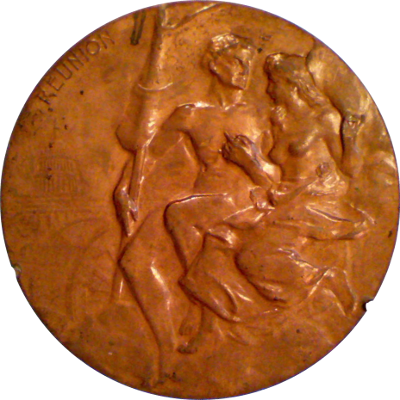Artist Name
You can click medals to switch between obverse and reverse sides.


This medal's obverse bears bust of younger, unbearded Lincoln three quarters right. Around top, ABRAHAM LINCOLN ★★★ PRESIDENT ★ 1861 ★ 1865; signed over shoulder at left, H. Ryden Sc. / C.H. HANSON. MFR.
The reverse bears draped couple holding hands, seated on a cannon, male holding Union banner, bare-breasted female looking at him; in background, the Capitol building. At upper left, REUNION
After presiding over the country's dissolution into Civil War, Abraham Lincoln was also the great uniter who, together with Grant, extended very generous terms to the South and meant to welcome them back as brothers after a long and bloody war. The medal's reverse can be interpreted both as an allegory for North and South coming together, but also as a very real occurrence of young couples being reunited after being separated by battle lines.
According to the notes, this medal came from the David Dreyfuss collection - lot 5720, 1986. It measures 63mm and was struck in copper by C.H. Hanson.
References: King 783


The obverse bears bearded bust of Dickens facing left. Above, CHARLES DICKENS; to left and right, 1812 - 1912.
The reverse bears laurel wreath around center inscription, TO / COMMEMORATE / THE / ONE HUNDREDTH / ANNIVERSARY / OF THE BIRTH OF / CHARLES DICKENS. / ISSUED BY THE / DICKENS CENTENARY / COMMITTEE / OF NEW YORK, / FEBRUARY 7 / 1912; below year, stamped STERLING.
The edge is marked WHITEHEAD - HOAG.
This is just one of many medals celebrating Charles Dickens. While the medal is not signed, a Whitehead-Hoag publication states that it was executed by Henning Ryden. No mintage has been reported.